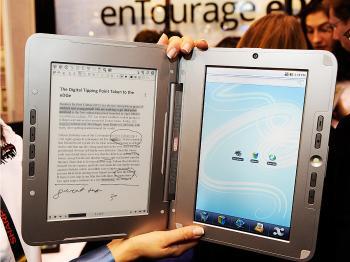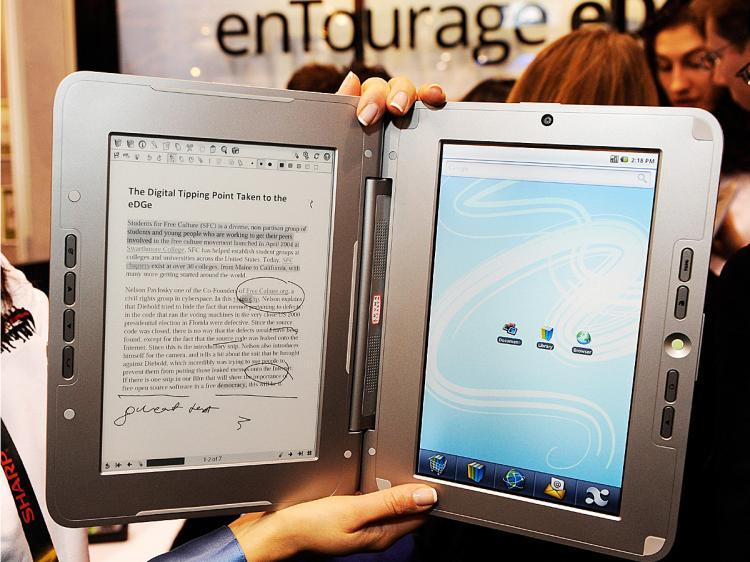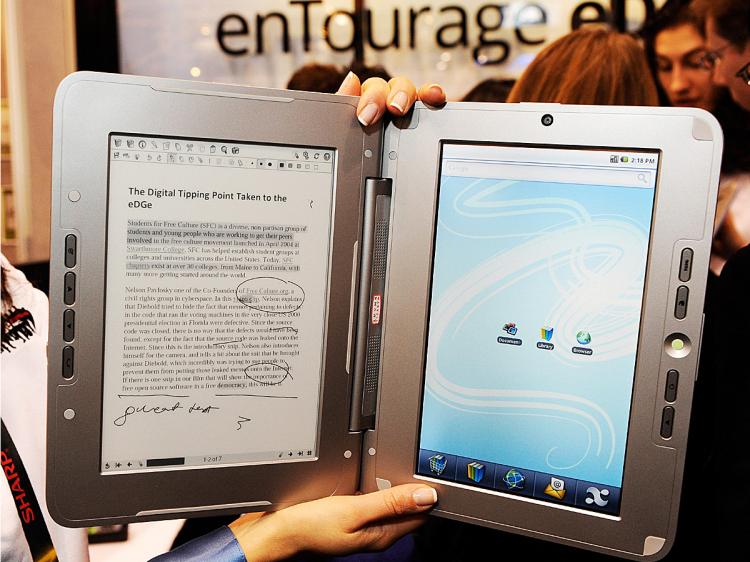Given plummeting school budgets and the slashing of programs, many students and educators are going digital and dumping traditional school and university textbooks.
With the economy in flux, going digital would save school systems millions of dollars, which could be used for programs that would be or already have been cut.
Promoting e-textbooks, Open Education said on its Web site that, “As the digital age continues to work its way into the stuffy world of academics, there are clear indications that textbooks are gradually being phased out in many areas of the country.”
A recent survey of educators by the California Learning Resource Network (CLN) found that more than half of school administrators believe that going digital will save the school system money that could be used otherwise. About 84 percent agree that e-textbooks would result in more up-to-date educational material and the majority asked CLN to undertake a study of e-textbook costs versus benefits.
A CompassLearning survey of educators, published this month, discovered that 65 percent expect e-textbooks to replace print textbooks in the very near future. But less than 20 percent thought that their school district could handle going digital at this time.
The e-textbook initiative started in earnest with Arnold Schwarzenegger, California’s governor, buying into the program in 2009. The initiative calls for California’s schools to go digital with textbooks.
“This first-in-the-nation initiative will reduce education costs. ... This initiative has the potential to save California’s schools millions of dollars,” Governor Schwarzenegger said in a 2009 press release.
California’s school system spent $350 million for schoolbooks and associated teaching materials, with one book costing between $75 and $100. The savings for just science and math class books are estimated to be around $2 million per school year.
Twelve schools in the Indianapolis public school system also began experimenting with e-textbooks, with a pilot program on tap for 2010, according to the Indianapolis Journal.
“Macmillan, considered one of the largest players in that old, conservative world, apparently has now also seen the ‘handwriting on the wall.’ The company recently announced it will offer academics an entirely new format: DynamicBooks,” Open Education said on its Web site.
The privately owned, U.K.-based Macmillan also offers the DynamicsBooks software, which gives professors the ability to change and customize textbooks for their classes. At the same time, it launched a Web site specifically tailored to the education crowd, christened “DynamicBooks.” This Web site details student, instructor, and author benefits of going textbook digital, highlighting the speed by which new textbooks are accessible and the advantage of interactive learning.
The upside to this new software is that the professors don’t need to get approval from the authors or publishers if changing or revising materials. There is a downside as experts caution about altering or rewriting textbook materials, even for just a limited number of people, as it could infringe on copyrights and existing licenses.
In the beginning of March, Apple Inc. announced that it would launch iPad on April 3. It took just a few days for textbook publishers, including McGraw-Hill Companies, Pearson PLC’s Pearson Education, and others to advise the educational world that the software from ScrollMotion would allow textbooks to be downloaded to the iPad, according to an article by Knowledge@Wharton (KW), the publishing arm of the University of Pennsylvania.
“Princeton University—which spent over $5 million on paper last year, one-fifth of which comprised printouts in student computing clusters—has launched a pilot program with the goal (among others) of determining whether students with electronic readers will print less paper,” according to “The Horizon Report 2010 Edition.”
Fairleigh Dickinson University’s library lets students check out all types of e-readers that hold different educational and noneducational materials.
A large number of universities have launched pilot programs that ask students to read their textbooks on e-readers, including the Amazon Kindle DX, Sony Reader, and enTourage eDGe.
Statistics indicate that the e-book market, driven by individual readers, has taken off and by 2018, it will have hauled in $9.6 billion in revenue assuming a projected annual growth rate of 43 percent. In 2009 alone, 22 million e-book readers were shipped, which earned $431 million in revenue, according to numbers published by Tech Crunchies?Internet Statistics and Numbers.
Publishers of school textbooks held monopoly power over prices of schoolbooks and are now facing extinction unless they move into the digital awareness age. It is not a secret to them “that their current model is doomed,” said Peter S. Fader, co-director of the Wharton Business School’s Interactive Media Initiative (WIMI), in a recent KW article.
The evolution of e-textbooks is influenced by a more complex set of factors: Decisions to go electronic at the university level are made by professors, while those of elementary and high schools are determined by school boards—but the individual will buy it, and thus the cost is distributed among numerous parties.
For elementary and high schools, the change to e-textbooks will be costly and face resistance from teachers and unions until they buy into it. But the California school system’s data shows that e-books save hundreds of dollars for cash-strapped schools and students alike.
To test the waters, the Wharton professors suggest that the e-textbook industry offer discount coupons for products the younger generation covets.
“For example, when students finish a chapter and show mastery by passing a self-assessment quiz, an ad could pop up suggesting they reward themselves with a run to the local Ben & Jerry’s,” according to the KW article.
E-books are downloaded into e-readers and don’t require paper products. When buying a book one doesn’t realize that for a ton of paper, 12 trees are cut down. Furthermore, recycling print materials is not a top priority, with only 5 percent of all paper turned in for recycling.
“The evolution [to E-textbooks] is inevitable. It’s just a question of when,” Fader said.
With the economy in flux, going digital would save school systems millions of dollars, which could be used for programs that would be or already have been cut.
Promoting e-textbooks, Open Education said on its Web site that, “As the digital age continues to work its way into the stuffy world of academics, there are clear indications that textbooks are gradually being phased out in many areas of the country.”
A recent survey of educators by the California Learning Resource Network (CLN) found that more than half of school administrators believe that going digital will save the school system money that could be used otherwise. About 84 percent agree that e-textbooks would result in more up-to-date educational material and the majority asked CLN to undertake a study of e-textbook costs versus benefits.
A CompassLearning survey of educators, published this month, discovered that 65 percent expect e-textbooks to replace print textbooks in the very near future. But less than 20 percent thought that their school district could handle going digital at this time.
California an Early Player
The e-textbook initiative started in earnest with Arnold Schwarzenegger, California’s governor, buying into the program in 2009. The initiative calls for California’s schools to go digital with textbooks.
“This first-in-the-nation initiative will reduce education costs. ... This initiative has the potential to save California’s schools millions of dollars,” Governor Schwarzenegger said in a 2009 press release.
California’s school system spent $350 million for schoolbooks and associated teaching materials, with one book costing between $75 and $100. The savings for just science and math class books are estimated to be around $2 million per school year.
Twelve schools in the Indianapolis public school system also began experimenting with e-textbooks, with a pilot program on tap for 2010, according to the Indianapolis Journal.
Publishers Onboard
“Macmillan, considered one of the largest players in that old, conservative world, apparently has now also seen the ‘handwriting on the wall.’ The company recently announced it will offer academics an entirely new format: DynamicBooks,” Open Education said on its Web site.
The privately owned, U.K.-based Macmillan also offers the DynamicsBooks software, which gives professors the ability to change and customize textbooks for their classes. At the same time, it launched a Web site specifically tailored to the education crowd, christened “DynamicBooks.” This Web site details student, instructor, and author benefits of going textbook digital, highlighting the speed by which new textbooks are accessible and the advantage of interactive learning.
The upside to this new software is that the professors don’t need to get approval from the authors or publishers if changing or revising materials. There is a downside as experts caution about altering or rewriting textbook materials, even for just a limited number of people, as it could infringe on copyrights and existing licenses.
In the beginning of March, Apple Inc. announced that it would launch iPad on April 3. It took just a few days for textbook publishers, including McGraw-Hill Companies, Pearson PLC’s Pearson Education, and others to advise the educational world that the software from ScrollMotion would allow textbooks to be downloaded to the iPad, according to an article by Knowledge@Wharton (KW), the publishing arm of the University of Pennsylvania.
“Princeton University—which spent over $5 million on paper last year, one-fifth of which comprised printouts in student computing clusters—has launched a pilot program with the goal (among others) of determining whether students with electronic readers will print less paper,” according to “The Horizon Report 2010 Edition.”
Fairleigh Dickinson University’s library lets students check out all types of e-readers that hold different educational and noneducational materials.
A large number of universities have launched pilot programs that ask students to read their textbooks on e-readers, including the Amazon Kindle DX, Sony Reader, and enTourage eDGe.
Printed Textbook Facing Extinction?
Statistics indicate that the e-book market, driven by individual readers, has taken off and by 2018, it will have hauled in $9.6 billion in revenue assuming a projected annual growth rate of 43 percent. In 2009 alone, 22 million e-book readers were shipped, which earned $431 million in revenue, according to numbers published by Tech Crunchies?Internet Statistics and Numbers.
Publishers of school textbooks held monopoly power over prices of schoolbooks and are now facing extinction unless they move into the digital awareness age. It is not a secret to them “that their current model is doomed,” said Peter S. Fader, co-director of the Wharton Business School’s Interactive Media Initiative (WIMI), in a recent KW article.
The evolution of e-textbooks is influenced by a more complex set of factors: Decisions to go electronic at the university level are made by professors, while those of elementary and high schools are determined by school boards—but the individual will buy it, and thus the cost is distributed among numerous parties.
For elementary and high schools, the change to e-textbooks will be costly and face resistance from teachers and unions until they buy into it. But the California school system’s data shows that e-books save hundreds of dollars for cash-strapped schools and students alike.
To test the waters, the Wharton professors suggest that the e-textbook industry offer discount coupons for products the younger generation covets.
“For example, when students finish a chapter and show mastery by passing a self-assessment quiz, an ad could pop up suggesting they reward themselves with a run to the local Ben & Jerry’s,” according to the KW article.
E-books are downloaded into e-readers and don’t require paper products. When buying a book one doesn’t realize that for a ton of paper, 12 trees are cut down. Furthermore, recycling print materials is not a top priority, with only 5 percent of all paper turned in for recycling.
“The evolution [to E-textbooks] is inevitable. It’s just a question of when,” Fader said.






